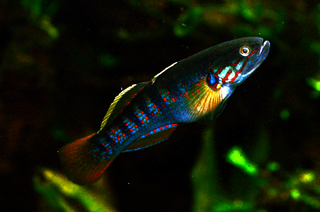
Eleotridae is a family of fish commonly known as sleeper gobies, with about 34 genera and 180 species. Most species are found in the tropical Indo-Pacific region, but there are also species in subtropical and temperate regions, warmer parts of the Americas and near the Atlantic coast in Africa. While many eleotrids pass through a planktonic stage in the sea and some spend their entire lives in the sea; as adults, the majority live in freshwater streams and brackish water. One of its genera, Caecieleotris, is troglobitic. They are especially important as predators in the freshwater stream ecosystems on oceanic islands such as New Zealand and Hawaii that otherwise lack the predatory fish families typical of nearby continents, such as catfish. Anatomically, they are similar to the gobies (Gobiidae), though unlike the majority of gobies, they do not have a pelvic sucker.

Gobiodon is a genus of gobies also known as coral gobies or "clown gobies". Generally, coral gobies, unlike the rest of the family Gobiidae, are not burrowers, but instead prefer to inhabit the branches of certain Acropora or similar hard corals.

Fusigobius is a genus of coral reef inhabiting gobies found throughout the Indian and western Pacific Oceans.

Eviota is a genus of fish in the family Gobiidae, commonly as dwarfgobies found in the Indo-Pacific region, where it is distributed from Japan to Australia and from Africa to Pitcairn Island. Species are mainly associated with coral reefs. Many of these fish are short-lived, with life cycles as brief as 3.5 weeks in the tropics. Some species are hermaphrodites and some representatives live symbiotically among the tentacles of the mushroom coral.

Amblyeleotris is a genus of fish in the family Gobiidae found throughout the Indo-Pacific region. This is the largest genus of the shrimp gobies or prawn gobies, so-called because of their symbiotic relationship with certain alpheid shrimps. The shrimp excavates and maintains a burrow used by both animals while the goby, which has far superior eyesight, acts as a lookout for predators. The shrimp maintains almost constant contact with the fish with an antenna. Fossil Amblyeleotris otoliths have been found together with alpheid shrimp remnants from as early as late early Miocene (Burdigalian) suggesting a possible mutualistic association since then.

Rhinogobius is a genus of primarily freshwater gobies native to tropical and temperate parts of eastern Asia. Most are small, streamlined in shape, and often sexually dimorphic. Few are of commercial importance, but R. duospilus is fairly widely traded as an aquarium fish.

Glossogobius is a genus of gobies native to fresh, brackish and marine waters from Africa to the coasts of the western Pacific Ocean. They are found in Madagascar, South Africa, Japan, Thailand, Australia, Indonesia, Bangladesh, the Philippines, Taiwan, Papua New Guinea, Singapore, Malawi, Eswatini, Botswana, Kenya, Zimbabwe, Tanzania, Mozambique, the Solomon Islands, Palau, Fiji, New Caledonia, India, Laos, Sri Lanka, Myanmar, Borneo, Nepal, Brunei Darussalam, Micronesia, Cambodia, Vietnam, China, Réunion, the Seychelles, Mauritius, the Caroline Islands, Vanuatu, Malaysia and Russia. The genus also includes a troglobitic species, G. ankaranensis.

Pseudanthias is a genus of colourful reef fishes of the subfamily Anthiinae, part of the family Serranidae, the groupers and sea basses. They are found in the Indo-Pacific. The species belonging to this genus have a diet consisting of zooplankton, and are haremic. Fishes currently included in this genus were earlier part of the genus Anthias. Pseudanthias is the largest anthiine genus

Cryptocentrus, also known as Watchman gobies, and one of the genera known as shrimp gobies or prawn gobies, is a genus of gobies native to tropical marine waters of the Indian and Pacific oceans.
Barbulifer is a genus of gobies native to the tropical Atlantic coast of the Americas as well as the Gulf of California on the Pacific coast.
Discordipinna is a genus of gobies native to the Indian Ocean and the western Pacific Ocean.
Egglestonichthys is a genus of gobies native to brackish and marine waters of the Indian Ocean and the western Pacific Ocean.

Myersina is a genus of ray-finned fish from the family Gobiidae, the true gobies which are found from the Atlantic coast of South Africa through the Indian Ocean to the western Pacific Ocean. The generic name honours the American ichthyologist George S. Myers (1905-1985) who was a younger colleague of Herre's at the time at which he described the genus and who went on to be president of the American Society of Ichthyologists and Herpetologists, the head of the Division of Fishes at the United States National Museum and an ichthyologist for the United States Fish and Wildlife Service.

Stonogobiops is a genus of gobies native to the Indian and Pacific oceans. This is one of the "shrimp goby" genera, the members of these genera being commensal with various species of shrimps.

Trimma is a genus of fish in the family Gobiidae native to the Indian and Pacific Ocean. Together with members of the genus Eviota, they are known commonly as pygmygobies or dwarfgobies.
Aioliops is a genus of dartfishes native to the central western Pacific Ocean.
Navigobius is a genus of fish in the family Microdesmidae native to the Indo-Pacific Ocean.

Ptereleotris is a genus of dartfishes found in the Atlantic, Indian and Pacific oceans.
Aioliops brachypterus, commonly known as the shortfin minidartfish, is a species of dartfish endemic to the lagoons of Miniloc Island, El Nido, Philippines. It is a small fish measuring around 17 to 24 mm in length. It has a grayish to pink body with a bright yellow stripe on the side and a dark spot on the tail fin. They swim in schools of up to 50 individuals.













